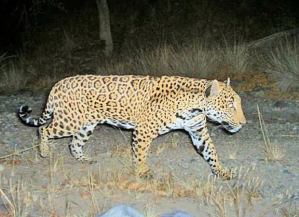by Tony Davis / Arizona Daily Star 
The U.S. proposed Friday to designate about 1,309 square miles across Southern Arizona and a sliver of New Mexico as prime habitat that is essential for conservation of the endangered jaguar.
Among those areas is the site of the proposed Rosemont Mine in the Santa Rita Mountains southeast of Tucson. That sets up a potential conflict between the big spotted cat’s stomping grounds and a project that would employ 400 people and be the fourth-largest copper mine in the United States.
In its proposal, the U.S. Fish and Wildlife Service said that if the critical habitat designation is approved, the agency will need to evaluate the 4,400-acre mine project to determine if it will be likely to destroy or significantly damage the jaguar habitat.
“It can’t be determined at this time” if the mine project would be incompatible with the habitat protection, said service spokesman Jeff Humphrey.
The Tucson-based Center for Biological Diversity, whose litigation led directly to the jaguar habitat proposal, said the mine is its biggest concern among all potential human threats to jaguar habitat.
Rosemont Copper officials didn’t respond to a request for comment on the habitat proposal.
Under federal law, destruction or “adverse modification” of critical habitat is illegal. Adverse modification typically means human activity that makes the lands no longer valuable for the endangered species, in this case the jaguar, Humphrey said.
The proposed critical habitat occupies mountain ranges in large swaths of rural Pima, Cochise and Santa Cruz counties in Arizona, along with a much smaller area of southwestern New Mexico, in Hidalgo County.
It includes areas known to have been occupied by jaguars since 1962, or land considered essential for the animal even if jaguars haven’t been seen there in recent decades.
One of these is the spot in Peñasco Canyon in the Atascosa Mountains west of Nogales where jaguar Macho B was captured, collared and released in February 2009. That led to three state and federal investigations after the jaguar was recaptured and euthanized.
Also included is a spot in the Whetstone Mountains, where a hunter photographed another male jaguar that was treed by his dogs in November 2011.
The critical habitat areas where jaguars haven’t been seen recently must meet important criteria, the Wildlife Service said: rugged terrain, expansive open spaces, availability of surface water and a minimal human presence, including lack of major roads or stable nighttime lighting.
The lands also must contain adequate jaguar prey, including deer, javelina, coatis, raccoons and jackrabbits; be somehow connected with Mexico; and contain 3 to 40 percent cover by Madrean woodlands including oak, juniper and pine, or by semidesert grasslands.
The secretive jaguars have been rare in this region since many were killed by government agents during the 20th century to protect livestock. Since 1996, a year before the Wildlife Service listed the cats as endangered, at least five different jaguars, all males, have been spotted by mountain lion hunters or by remote photography in Southern Arizona and southwest New Mexico. They are thought to be roaming north from Mexico.
There is still disagreement among some scientists as to whether Southern Arizona can support a permanent jaguar population. Some believe that jaguar conservation and recovery activities should be focused in northern Mexico and points south, where the animals are more common. But the Center for Biological Diversity contends this region could support an expanded jaguar population.
The Rosemont Mine was the only major project spelled out in the federal proposal that could potentially damage jaguar habitat. The Wildlife Service is already reviewing the mine project to determine if it will jeopardize 10 federally protected species, including the jaguar. But critical habitat protection is generally more sweeping than protection of individual species.
“This is just huge. I’m pleasantly surprised. The agency has gone out of its way to flag Rosemont as a threat,” said Kieran Suckling, the Center for Biological Diversity’s executive director. “This is a very clear shot across Rosemont’s bow. They’ve got a really big problem.”
The standard that “adverse modification” to critical habitat must be avoided is a “very high bar, tough to pass” for a project that would be located in such an area, the Wildlife Service’s Humphrey said. But at this point, the critical habitat is just a proposal, and it will be a year before the service decides whether to approve it, he said.
